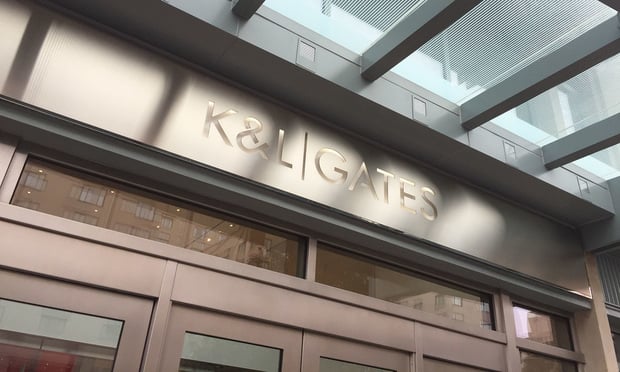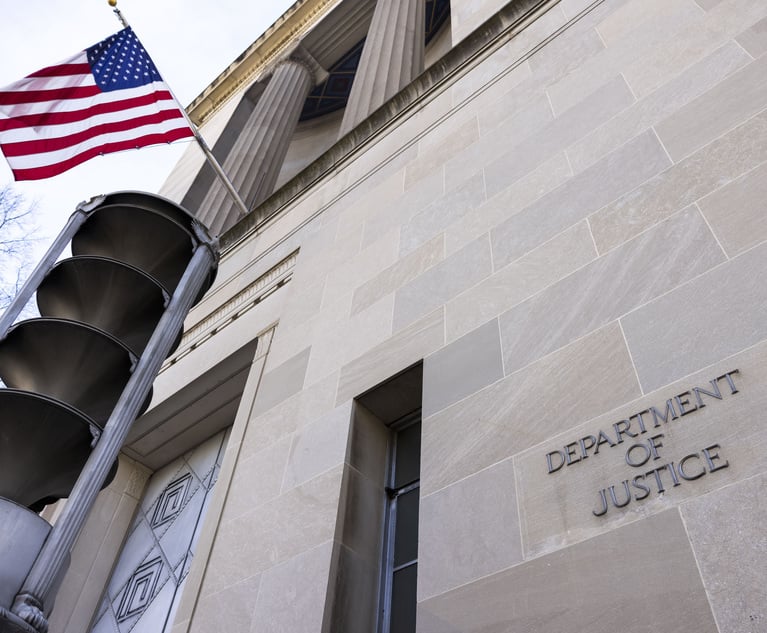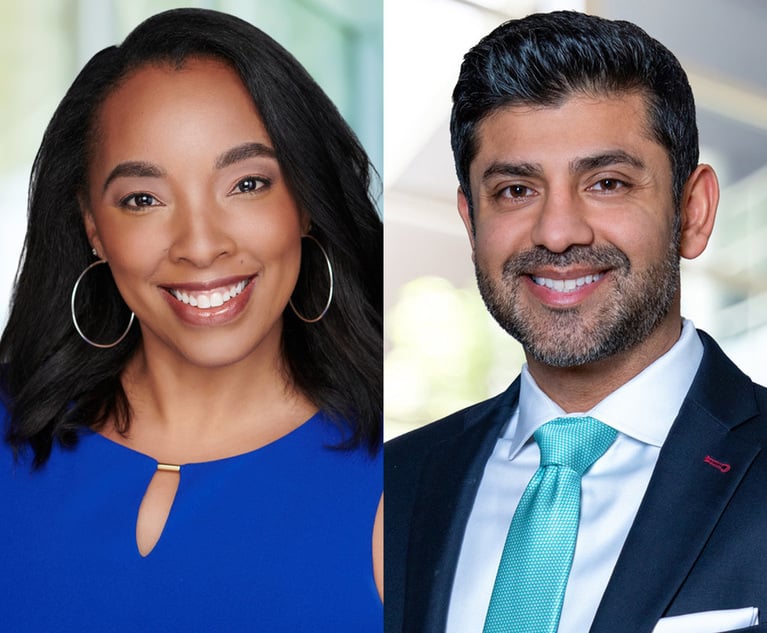K&L Gates Defections Follow Years of Financial Declines
Overseas and U.S. departures have continued as many of the firm's peers in the upper reaches of the industry left K&L Gates behind.
November 25, 2019 at 01:14 PM
8 minute read
The original version of this story was published on The Legal Intelligencer
 K&L Gates in Washington, D.C. (Photo : Diego M. Radzinschi/ALM)
K&L Gates in Washington, D.C. (Photo : Diego M. Radzinschi/ALM)
The exodus of nearly 30 lawyers from K&L Gates in Australia this month was only the latest in a string of high-profile exits for the firm.
In the 12 months leading up to that group's departure, Pittsburgh-headquartered K&L Gates experienced a net loss of 56 lawyers, according to lateral move data from ALM Intelligence's Legal Compass. The firm had a total of 1,756 lawyers in 2018.
A closer look shows the firm lost 96 partners from December 2018 through October, according to ALM Intelligence data, while it has added 32 partners across all of its offices since November 2018. The attrition extends a longer-term trend of shrinking lawyer head counts for the firm, which has also struggled to keep pace financially with many peer firms in the Am Law 100.
The firm reported 812 total partners for 2018—a net loss of 64 that represents 7.9% of the partnership. Those partner defections were spread across the firm: 17 in Warsaw, 10 in Pittsburgh, six in London and five in Boston, for example.
Looking at the rest of its lawyer ranks, K&L Gates hired 59 counsel and lost 61 from mid-November 2018 to mid-November 2019, data showed. It did hire more associates than it lost—164 hires compared with 154 departures. The greatest associate hiring was in Singapore, followed by Pittsburgh and Seattle, then Charlotte and Boston—though Pittsburgh, Seattle and Charlotte were also among the top offices for associate defections.
K&L Gates chairman Michael Caccese and managing partner James Segerdahl were not available for interviews, according to a firm spokesman.
"As a firm, we are quite pleased with the laterals who have joined us over the last several years. In the aggregate, their practices have been substantially accretive, and they have added in many cases key capability and bench strength across the extensive K&L Gates platform," the spokesman said in a statement. "While partners depart law firms from time to time for any number of reasons, K&L Gates has continued to gain strength and momentum in accordance with our strategic direction, including through the lateral markets."
Law.com International reported on the departures in Australia last month—the latest in a series of exits from the firm's offices down under that began earlier in the year. The most recent group of 28 lawyers, which included nine K&L Gates partners, have now acknowledged it plans to launch a new employment law firm, with offices in Sydney, Melbourne and Perth.
In a statement on the latest group departure, Australia managing partner Nick Nichola said the firm wishes them well.
"Our discussions with them have highlighted that with their specific focus on workplace laws, where cross-practice advice is required there will be opportunities to continue to work together to solve client problems and we look forward to doing so," Nichola said. "K&L Gates' ongoing Australian labour, employment and workplace safety team remains strong."
K&L's Eastern European presence also shrank this year, when the firm pulled out of Poland in May and sold its 85-person Warsaw office to U.K.-based DWF. Also internationally, K&L lost a pair of Beijing-based M&A partners to White & Case in July.
Stateside, the firm has seen some noteworthy departures as well. A group of four lawyers went to midsize firm Miller, Canfield, Paddock and Stone in Washington, D.C., over the summer, and later launched a Qatar office for their new firm.
Three employee benefits partners left the Charlotte office for Troutman Sanders, following a group of lawyers who left K&L to launch Troutman's local office in 2014.
Pillsbury Winthrop Shaw Pittman nabbed K&L's Silicon Valley office leader, IP partner Michael Zeliger, in May, then took two more IP partners from K&L in July.
And in Dallas, office managing partner John Garda left to join litigation funder Longford Capital in April.
K&L Gates' lawyer head count has been on a steady decline since 2014, when the firm reported having 1,975 lawyers, its peak size.
In a September 2018 interview, Segerdahl, when asked about the firm's head count declines over the years, said, "It's a combination of expense management and continually trying to drive toward a really, really top notch talent pool." He added, "A firm our size is always going to have some movement in and out—some of it firm-initiated, some of it not."
The greatest annual loss in the years since was 100 lawyers from 2015 to 2016. That year, the firm experienced a net loss of 42 equity partners and 100 associates, and a net gain of 32 nonequity partners and 74 other (nonpartner and non-associate) attorneys.
Behind those numbers was the departure of 90 partners over the course of seven months in 2015. Then-chairman Peter Kalis and others attributed this to the firm's efforts to trim unproductive partners from the nonequity ranks—however, as the data shows, the nonequity tier actually grew.
The firm experienced a gross revenue decline of 7% that year.
The next year, in 2016, K&L suffered several high-profile departures, including California litigator John Pierce and a 32-lawyer consumer lending regulatory group in D.C.
But that same year, the firm experienced a windfall—it collected a $210 million success fee in 2016. That fee came from a $1.5 billion patent infringement judgment against Marvell Technology Group Ltd, and ultimately a $750 million settlement for Carnegie Mellon University.
To put the size of that fee in context, K&L Gates had net income of $182.7 million the year before. The effects were apparent in the firm's financial results. The firm reported revenue growth of 10.7% in its 2016 fiscal year, more than making up for the prior year's 7% decline in gross revenue.
Still, another string of partners left in early 2017, and the firm laid off a substantial number of employees.
Asked in September 2018 about the effect of the contingency fee on K&L's financial performance, and whether it allowed the firm to stay debt-free (a status it had boasted for years, and confirmed was still in place in 2018), Caccese and Segerdahl offered few details.
"It was a nice fee. [There were] lots of pieces to that equation, really. We were happy with it," Segerdahl said.
Caccese simply answered: "We can't speak to that much beyond [the financial information] we've provided" in the past.
But the next year, gross revenue was down again, declining by 16.4%—though a spokesman for the firm said in 2018 that 2017 revenue, when adjusted for the effects of the Carnegie Mellon fee, actually was 2% better than 2016. Still, K&L's gross revenue had dipped below $1 billion for the first time since 2009.
Its revenue bounced back up above the $1 billion mark in 2018, growing 1.8% year-to-year. But in what was a stellar year for much of the Am Law 100, that gain was not enough to keep up with the rest.
Falling Behind
The performance of the rest of the Am Law 50 puts K&L's financial results in context.
Volatility certainly hasn't been uncommon among Am Law 200 firms in recent years, but the Am Law 50 has largely forged ahead post-Great Recession.
K&L Gates, however, has seen its standing in the Am Law 50 slip more than 20 places in eight years. It was the 16th largest law firm by revenue on the 2011 Am Law 100, which was based on 2010 financial performance. In 2019, it came in 37th.
Even in the years when K&L Gates reported strong gross revenue gains, it wasn't able to overtake many of its peers. For the 2014 Am Law 100, when gross revenue was up 9% (from 2012 to 2013), it only inched ahead one additional place. Same for the 2017 Am Law 100, when it reported 10.7% growth thanks to the Carnegie Mellon fee.
Meanwhile, its profit margin suffered, going from 26% in 2010 (which was still the third-smallest profit margin among Am Law 50 firms that year) to 17% in 2017. It ticked up slightly to 18% last year.
While that may be surprising, given that profits per equity partner in 2018 were $990,000, versus $930,000 in 2010, profits per lawyer tell a different story.
From 2010 to 2018, profits per lawyer declined nearly 35%, from $155,088 to $101,000. They bottomed out in 2017, at $92,000.
Looking at revenue per lawyer, often seen as the best measure of a firm's financial health, even in 2010 K&L Gates had RPL that ranked within the bottom half of the Am Law 200.
But as of last year, only 35 firms in the entire Am Law 200 have lower RPL than K&L Gates. Five of them are Am Law 100 firms, and none of them are also in the Am Law 50.
This content has been archived. It is available through our partners, LexisNexis® and Bloomberg Law.
To view this content, please continue to their sites.
Not a Lexis Subscriber?
Subscribe Now
Not a Bloomberg Law Subscriber?
Subscribe Now
NOT FOR REPRINT
© 2025 ALM Global, LLC, All Rights Reserved. Request academic re-use from www.copyright.com. All other uses, submit a request to [email protected]. For more information visit Asset & Logo Licensing.
You Might Like
View All
Government Attorneys Face Reassignment, Rescinded Job Offers in First Days of Trump Administration
4 minute read


Energy Lawyers Field Client Questions as Trump Issues Executive Orders on Industry Funding, Oversight
6 minute readLaw Firms Mentioned
Trending Stories
- 1We the People?
- 2New York-Based Skadden Team Joins White & Case Group in Mexico City for Citigroup Demerger
- 3No Two Wildfires Alike: Lawyers Take Different Legal Strategies in California
- 4Poop-Themed Dog Toy OK as Parody, but Still Tarnished Jack Daniel’s Brand, Court Says
- 5Meet the New President of NY's Association of Trial Court Jurists
Who Got The Work
J. Brugh Lower of Gibbons has entered an appearance for industrial equipment supplier Devco Corporation in a pending trademark infringement lawsuit. The suit, accusing the defendant of selling knock-off Graco products, was filed Dec. 18 in New Jersey District Court by Rivkin Radler on behalf of Graco Inc. and Graco Minnesota. The case, assigned to U.S. District Judge Zahid N. Quraishi, is 3:24-cv-11294, Graco Inc. et al v. Devco Corporation.
Who Got The Work
Rebecca Maller-Stein and Kent A. Yalowitz of Arnold & Porter Kaye Scholer have entered their appearances for Hanaco Venture Capital and its executives, Lior Prosor and David Frankel, in a pending securities lawsuit. The action, filed on Dec. 24 in New York Southern District Court by Zell, Aron & Co. on behalf of Goldeneye Advisors, accuses the defendants of negligently and fraudulently managing the plaintiff's $1 million investment. The case, assigned to U.S. District Judge Vernon S. Broderick, is 1:24-cv-09918, Goldeneye Advisors, LLC v. Hanaco Venture Capital, Ltd. et al.
Who Got The Work
Attorneys from A&O Shearman has stepped in as defense counsel for Toronto-Dominion Bank and other defendants in a pending securities class action. The suit, filed Dec. 11 in New York Southern District Court by Bleichmar Fonti & Auld, accuses the defendants of concealing the bank's 'pervasive' deficiencies in regards to its compliance with the Bank Secrecy Act and the quality of its anti-money laundering controls. The case, assigned to U.S. District Judge Arun Subramanian, is 1:24-cv-09445, Gonzalez v. The Toronto-Dominion Bank et al.
Who Got The Work
Crown Castle International, a Pennsylvania company providing shared communications infrastructure, has turned to Luke D. Wolf of Gordon Rees Scully Mansukhani to fend off a pending breach-of-contract lawsuit. The court action, filed Nov. 25 in Michigan Eastern District Court by Hooper Hathaway PC on behalf of The Town Residences LLC, accuses Crown Castle of failing to transfer approximately $30,000 in utility payments from T-Mobile in breach of a roof-top lease and assignment agreement. The case, assigned to U.S. District Judge Susan K. Declercq, is 2:24-cv-13131, The Town Residences LLC v. T-Mobile US, Inc. et al.
Who Got The Work
Wilfred P. Coronato and Daniel M. Schwartz of McCarter & English have stepped in as defense counsel to Electrolux Home Products Inc. in a pending product liability lawsuit. The court action, filed Nov. 26 in New York Eastern District Court by Poulos Lopiccolo PC and Nagel Rice LLP on behalf of David Stern, alleges that the defendant's refrigerators’ drawers and shelving repeatedly break and fall apart within months after purchase. The case, assigned to U.S. District Judge Joan M. Azrack, is 2:24-cv-08204, Stern v. Electrolux Home Products, Inc.
Featured Firms
Law Offices of Gary Martin Hays & Associates, P.C.
(470) 294-1674
Law Offices of Mark E. Salomone
(857) 444-6468
Smith & Hassler
(713) 739-1250










